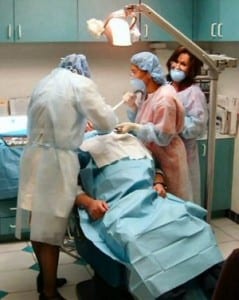 “A friend of mine told me that she recently experienced an earache. She has not had one since she was a kid. After an ENT examined her, he said it was TMJ – OMG! With all of the acronyms in our society today, I jokingly said ‘too much jewelry?’ Little did I know that this is no joking matter. She indicated that she had a dental condition, but was vague with her answers to my questions. I can only assume that she does not understand the condition and may be too embarrassed to ask. Can you explain?
“A friend of mine told me that she recently experienced an earache. She has not had one since she was a kid. After an ENT examined her, he said it was TMJ – OMG! With all of the acronyms in our society today, I jokingly said ‘too much jewelry?’ Little did I know that this is no joking matter. She indicated that she had a dental condition, but was vague with her answers to my questions. I can only assume that she does not understand the condition and may be too embarrassed to ask. Can you explain?
TMJ stands for temporomandibular joint dysfunction. On either side of your mouth, just in front of your ears, the lower jaw attaches to the skull with muscles (pterygoid) and ligaments that enable you to open, close, chew and speak. When these muscles are strained or constricted by movement for any reason, pain and discomfort are manifested in the muscles and limit proper operational function of the jaw.
TMJ may result from an accident involving the face, grinding of the teeth, misalignment of the jaw and even arthritis. When the mouth is opened for a prolonged period of time during a dental procedure, “locking of the jaw,” or the inability to properly open and close the joint, can also result.
When the muscles are palpated (manipulated) and pain is elicited during an examination, this does indicate TMJ symptoms. Other symptoms include jaw clicking (from the disc), headaches, neck and/or shoulder pain, possible facial swelling and ear discomfort. These symptoms do, however, mask neurological problems. Therefore, a correct diagnosis is imperative to determine the right course of therapy.
TMJ symptoms can be addressed in various ways, depending on the severity and the source of pain. We suggest applying a hot pack, such as a moist, heated towel, or cold pack to the sites of pain for 20 minutes, three to five times per day. Eating soft foods cut in small pieces and avoiding such foods as chewing gum, caramels, carrots, steak and bagels are recommended lifestyle changes.
If the situation is not resolved, an acrylic night guard (or bite plate) appliance may be an effective treatment option. Our treatment goal is to break the cycle of actions that cause pain.
“When I was younger, I had such straight teeth and a beautiful smile. Over the years, my teeth have shifted around. I saw an orthodontist, but he said I need to see a periodontist first! Why?”
When the teeth shift, it is usually a sign of periodontal disease, which can destroy the bone that support the teeth. When the support is weakened, eating or grinding or clenching the teeth can cause them to start moving.
Before initiating orthodontic therapy, or movement of the teeth into correct position, any infection and damaged bone should be rebuilt. Taking this first step will allow successful completion of orthodontic treatment, and give you back your beautiful smile.
Dr. Kessler’s office is located in the Dadeland Medical building, 7400 North Kendall Drive, Suite 601. For more information, call (305) 670-3800 or go to <www.WeSaveSmiles.com>.






